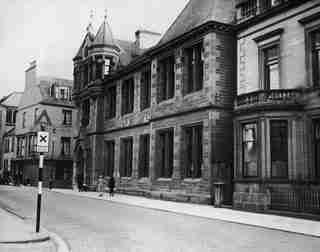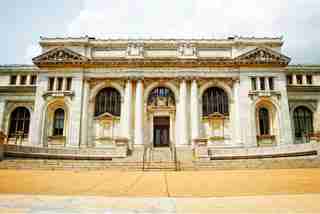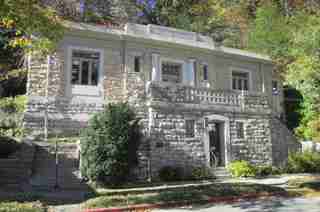After the Scottish steel magnate Andrew Carnegie made his millions during the Industrial Revolution, he turned to philanthropy. From 1886 to 1919, he donated roughly $55 million to help build over 2,500 libraries throughout the U.S. and around the world. Carnegie felt that anyone with access to books and the desire to learn could educate themselves and become successful. In order to win an endowment, communities were required to apply for Carnegie’s grants, and, especially in the later years, had to adhere to certain design requirements. As a result, many of the libraries funded by Carnegie have similar architectural elements, including arched windows and symmetrical columns near the front entrance. Here, AD tours nine beautiful libraries that would not have been possible had it not been for Andrew Carnegie.

Central Library, Dunfermline, Scotland
The world’s first library to be constructed through Carnegie’s endowment was built in his home town of Dunfermline, Scotland. He offered to give the town £5,000 for construction (which amounts to roughly $170,000 today), and the building opened in 1883 with its memorial stone being laid by Carnegie’s mother, Margaret. The architect, James Campbell Walker of Edinburgh, incorporated a variety of styles in the design, including a Gothic front entrance and château-esque turrets that rose from the rooftop.

The Carnegie Library at Mt. Vernon Square, Washington, D.C.
Opened in 1902, this beautiful example of Beaux Arts architecture was designed by the New York firm Ackerman & Ross. It was used as a library for over 70 years before it became too small for its collection. Today, the building is available to rent as an event space.

Eureka Springs Carnegie Library, Eureka Springs, Arkansas
Completed in 1912, this Classical Revival–style library was built from locally quarried limestone by St. Louis architect George W. Hellmuth. To this day, the building is still being used as a library.
The Oklahoma Territorial Museum, Guthrie, Oklahoma
Today it’s the Oklahoma Territorial Museum, yet back in 1907, the library was the site of the inauguration of Oklahoma’s first governor. Designed by architect J. H. Bennett and completed in 1902, the building reflects the Renaissance Revival style of architecture popular at the beginning of the 20th century.
Carnegie Library, Beaumont, California
Located in the city of Beaumont, California, the Carnegie Library was opened in 1914. The library was designed by architect E. L. Hopkins, who composed the structure with symmetrical windows and doors in a Classical Revival style.
Springfield City Library, Springfield, Massachusetts
Built in the Italian Renaissance Revival style, this library opened in 1912. The extensive support and enthusiasm of the local community led Carnegie to increase his original donation, resulting in an elegant building with a base of pink granite, walls of white Vermont marble, and an expensive green tile roof. There is a bronze bust of Carnegie in the rotunda.
Missoula Art Museum, Missoula, Montana
Currently an art museum, this Carnegie library was built in 1903 and designed by architect A. J. Gibson in the Classical Revival style, with white columns formally welcoming visitors at the front. In 1912, architect Ole Bakke added a second-floor expansion, which reflects the horizontally focused Prairie School architecture that was sweeping across America at the turn of century.
The Tucson Children’s Museum, Tucson, Arizona
With its symmetrical columns and windows, this library, which opened in 1901, was designed by Henry Trost in the Classical Revival style. It operated as a library until 1990, with the Children’s Museum taking it over shortly thereafter.
The Dalles Art Association, The Dalles, Oregon
Finished in 1910, this brick structure was used as a library for over 50 years until it was turned into a center for the arts. The building was designed in the Beaux Arts style, with arched windows and a raised first floor.
